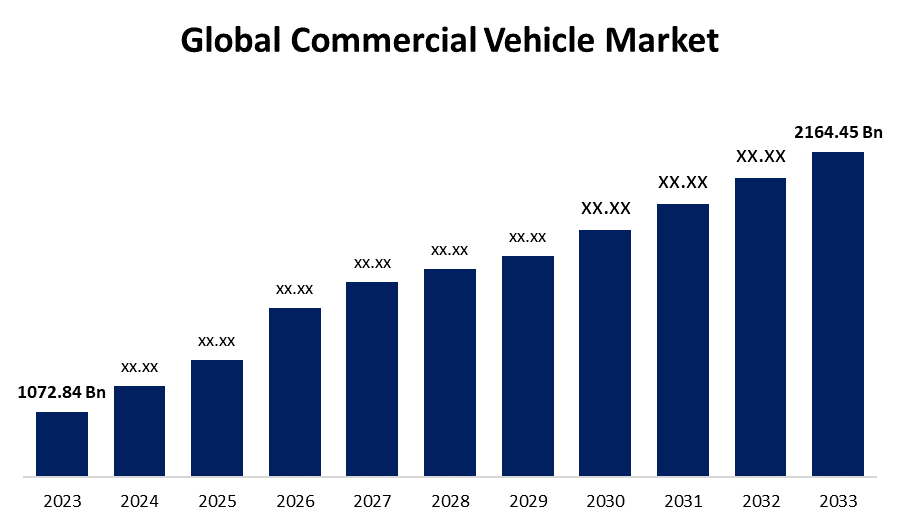Global Commercial Vehicle Market Size, Share, and COVID-19 Impact Analysis, By Vehicle Type (Light Commercial Vehicle, Heavy Vehicle, and Buses), By Fuel Type (I.C. Engine, Electric Vehicle (EV)), By End User (Industrial, Mining, Construction, Logistics), and By Region (North America, Europe, Asia-Pacific, Latin America, Middle East, and Africa), Analysis and Forecast 2023 - 2033.
Industry: Automotive & TransportationGlobal Commercial Vehicle Market Insights Forecasts to 2033
- The Global Commercial Vehicle Market Size was Valued at USD 1,072.84 Billion in 2023
- The Market Size is Growing at a CAGR of 7.27% from 2023 to 2033
- The Worldwide Commercial Vehicle Market Size is Expected to Reach USD 2,164.45 Billion by 2033
- Asia Pacific is Expected to Grow the fastest during the forecast period.

Get more details on this report -
The Global Commercial Vehicle Market Size is Anticipated to Exceed USD 2,164.45 Billion by 2033, Growing at a CAGR of 7.27% from 2023 to 2033.
Market Overview
Any motor vehicle that is used primarily for the transportation of products or passengers who are prepared to pay for their rides is considered a commercial vehicle. From the typical delivery vans that travel city streets to the large tractor-trailers that drive vast highways, this broad category comprises a wide variety of vehicles. A commercial vehicle's specific classification change based on local laws and weight limitations. Worldwide economic activity and infrastructural development are made possible by the transportation of people and products by commercial vehicles. The increase is predicted to be driven by the implementation of vehicle scrappage programs, significant expenditures in rural and infrastructural development, and the drafting of strict regulatory standards about vehicle length weight restrictions, and other factors. Growth is also anticipated as a result of the global mining industry's resurgence, which has increased demand for tippers. The growing demand for small commercial vehicles due to the increasing logistic services offered by the local market is expected to drive the commercial vehicle market in the forecast period. The commercial vehicle market will grow as a result of financial support, government initiatives, and increased investments from manufacturing companies.
Report Coverage
This research report categorizes the market for the global commercial vehicle market based on various segments and regions forecasts revenue growth and analyzes trends in each submarket. The report analyses the key growth drivers, opportunities, and challenges influencing the global commercial vehicle market. Recent market developments and competitive strategies such as expansion, product launch, and development, partnership, merger, and acquisition have been included to draw the competitive landscape in the market. The report strategically identifies and profiles the key market players and analyses their core competencies in each sub-segment of the global commercial vehicle market.
Global Commercial Vehicle Market Report Coverage
| Report Coverage | Details |
|---|---|
| Base Year: | 2023 |
| Market Size in 2023: | USD 1,072.84 Billion |
| Forecast Period: | 2023 - 2033 |
| Forecast Period CAGR 2023 - 2033 : | 7.27% |
| 2033 Value Projection: | USD 2,164.45 Billion |
| Historical Data for: | 2019-2022 |
| No. of Pages: | 235 |
| Tables, Charts & Figures: | 110 |
| Segments covered: | By Vehicle Type, By Fuel Type, By End User |
| Companies covered:: | Daimler AG, PACCAR Inc., Hino, VE Commercial Vehicles Ltd, Scania, Tata Motors, Navistar International Corp, BYD Auto Co., Ltd., AB Volvo, Toyota Motor Corporation, Ashok Leyland, Bosch Rexroth AG, Volkswagen AG, Mahindra and Mahindra, and Others |
| Pitfalls & Challenges: | Covid 19 Impact Challanges, Future, Growth and Analysis |
Get more details on this report -
Driving Factors
The demand for commercial vehicles is driven by the growth of economies, especially in emerging regions. The necessity for commercial vehicles expanded due to the rapid expansion of infrastructure, urbanization, and industrialization, which increased the requirement for commodities transportation. Effective last-mile delivery solutions are required due to the rise in e-commerce activity and shifting customer preferences toward online buying. Smaller commercial vehicles designed for delivery in cities are in greater demand as an effect of technology. Stricter emission regulations are being imposed by governments everywhere to reduce pollution and advance environmental sustainability. This has driven innovation in the industry by pushing manufacturers to create commercial cars that are hybrid, electric, and run on renewable energies.
Restraining Factors
The high production costs and complicated mechanisms of advanced systems are projected to restrict market growth as the automobile industry transitions to electrification and the use of advanced technologies in vehicles. The high cost of software installation, large capital expenditure, and the expensive lithium-ion batteries that are utilized in cars all contribute to the increased cost of production.
Market Segmentation
The global commercial vehicle market share is classified into vehicle type, fuel type, and end user.
- The light commercial vehicle segment is expected to hold the largest share of the global commercial vehicle market during the forecast period.
Based on the vehicle type, the global commercial vehicle market is divided into light commercial vehicles, heavy vehicles, and buses. Among these, the light commercial vehicle segment is expected to hold the largest share of the global commercial vehicle market during the forecast period. LCVs have several tax benefits and lower emissions. Additionally, these cars are quite versatile and active for transporting both people as well as products. The category of light commercial vehicles is due to its greatest application in localized logistical operations. It is anticipated to hold the majority of the worldwide market.
- The electric vehicle (EV) segment is expected to hold the largest share of the global commercial vehicle market during the forecast period.
Based on the fuel type, the global commercial vehicle market is divided into I.C. engine and electric vehicle (EV). Among these, the electric vehicle (EV) segment is expected to hold the largest share of the global commercial vehicle market during the forecast period. The EV market is expected to grow at a promising rate as a result of increased demand and higher fuel economy compliance regulations. Additionally, manufacturers are always concentrating on lowering the battery price to improve EV sales, which is driving the growth of the global market. Commercial EVs offer a longer driving range and generate no noise or air pollution as compared to traditional combustion engines.
- The logistics segment is expected to hold the largest share of the global commercial vehicle market during the forecast period.
Based on the end user, the global commercial vehicle market is divided into industrial, mining, construction, and logistics. Among these, the logistics segment is expected to hold the largest share of the global commercial vehicle market during the forecast period. Two significant reasons that are anticipated to propel the growth of the logistics sector are the preservation of gains in global trade and the protection of the logistics infrastructure. The e-commerce sector's continuous rise is also encouraging for the logistics sector's future development.
Regional Segment Analysis of the Global Commercial Vehicle Market
- North America (U.S., Canada, Mexico)
- Europe (Germany, France, U.K., Italy, Spain, Rest of Europe)
- Asia-Pacific (China, Japan, India, Rest of APAC)
- South America (Brazil and the Rest of South America)
- The Middle East and Africa (UAE, South Africa, Rest of MEA)
North America is anticipated to hold the largest share of the global commercial vehicle market over the predicted timeframe.

Get more details on this report -
North America is anticipated to hold the largest share of the global commercial vehicle market over the predicted timeframe. The highly integrated supply chain network in North America drives market growth by effectively connecting producers and customers through a variety of transportation channels, such as freight rail, air, and express delivery services maritime transport, and truck transport. Some of the elements that are anticipated to support the expansion of the regional market include the accessibility of easy financing choices, the aggressive expenditures made in infrastructure development by regional governments, and the significant focus placed on ensuring domestic auto manufacturing.
Asia Pacific is expected to grow at the fastest pace in the global commercial vehicle market during the forecast period. The need for unified logistics, transportation, and warehousing solutions is expanding in the region of Asia-Pacific. Some of the factors that are anticipated to contribute to the growth of the regional market are the improving road infrastructure, the easy access to affordable labor and raw materials, and consequently the increasing number of manufacturing facilities, particularly in developing economies like China and India.
Competitive Analysis:
The report offers the appropriate analysis of the key organizations/companies involved within the global commercial vehicle market along with a comparative evaluation primarily based on their product offering, business overviews, geographic presence, enterprise strategies, segment market share, and SWOT analysis. The report also provides an elaborative analysis focusing on the current news and developments of the companies, which includes product development, innovations, joint ventures, partnerships, mergers & acquisitions, strategic alliances, and others. This allows for the evaluation of the overall competition within the market.
List of Key Companies
- Daimler AG
- PACCAR Inc.
- Hino
- VE Commercial Vehicles Ltd
- Scania
- Tata Motors
- Navistar International Corp
- BYD Auto Co., Ltd.
- AB Volvo
- Toyota Motor Corporation
- Ashok Leyland
- Bosch Rexroth AG
- Volkswagen AG
- Mahindra and Mahindra
- Others
Key Target Audience
- Market Players
- Investors
- End-users
- Government Authorities
- Consulting And Research Firm
- Venture capitalists
- Value-Added Resellers (VARs)
Recent Developments
- In February 2024, A joint venture between the Volvo Group of Sweden and Eicher Motors, VE Commercial Vehicles Ltd., entered the small commercial vehicle market by launching an electric vehicle in the rapidly expanding 2-3.5 gross vehicle weight (GVW) pick-up sector.
- In January 2024, A 5 lakh commercial vehicle fleet edge connection was announced by Tata Motors. For effective fleet administration of commercial vehicles, a specialized connected vehicle platform was created. In addition to sharing actionable insights in real-time on the location, health, and driving habits of every vehicle it is connected to, Fleet Edge leverages smart technologies to boost vehicle uptime and enhance road safety. Reduced logistics costs and increased earnings, improved operational efficiency.
Market Segment
This study forecasts revenue at global, regional, and country levels from 2020 to 2033. Spherical Insights has segmented the global commercial vehicle market based on the below-mentioned segments:
Global Commercial Vehicle Market, By Vehicle Type
- Light Commercial Vehicle
- Heavy Vehicle
- Buses
Global Commercial Vehicle Market, By Fuel Type
- I.C. Engine
- Electric Vehicle (EV)
Global Commercial Vehicle Market, By End User
- Industrial
- Mining
- Construction
- Logistics
Global Commercial Vehicle Market, By Regional
- North America
- US
- Canada
- Mexico
- Europe
- Germany
- Uk
- France
- Italy
- Spain
- Russia
- Rest of Europe
- Asia Pacific
- China
- Japan
- India
- South Korea
- Australia
- Rest of Asia Pacific
- South America
- Brazil
- Argentina
- Rest of South America
- Middle East & Africa
- UAE
- Saudi Arabia
- Qatar
- South Africa
- Rest of the Middle East & Africa
Need help to buy this report?